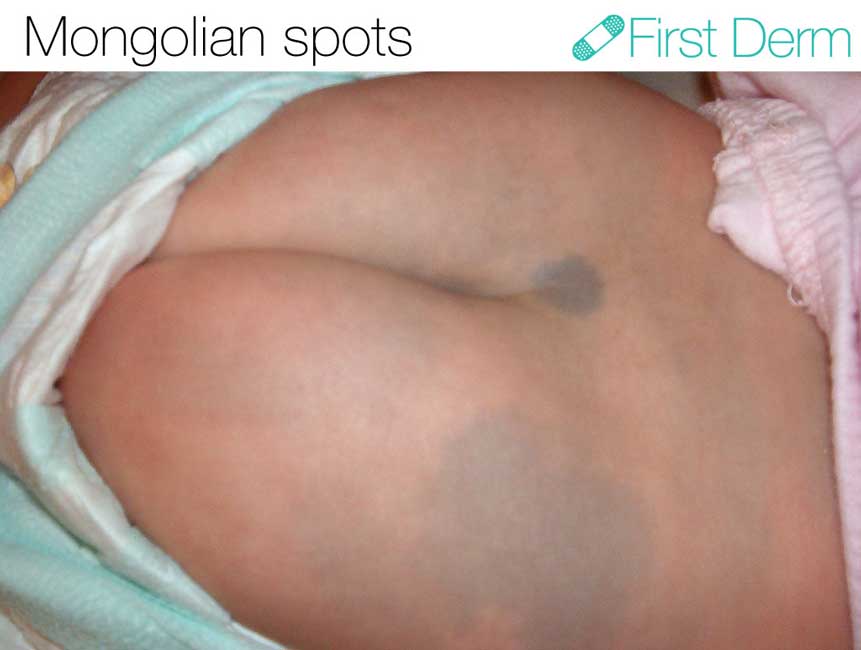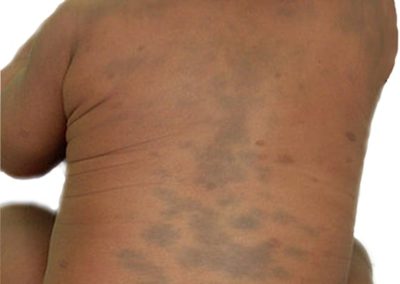Mongolian spots
Medically reviewed by The Dermatologists and written by Dr. Alexander Börve
Common
More than 200,000 US cases per year
- Often self-diagnosable
- Symptoms: Birthmark that looks like bruising of the skin
- Color: Typically dark brown or bluish black
- Location: Anywhere on the skin
- Treatment: Lower back region and buttocks.
A mongolian spot is a birthmark that looks a lot like a bruising of the skin, usually at the bottom of the back or on the buttocks. They are typically seen on dark-pigmented newborns or within the first weeks of the neonatal period.
Try our FREE dermatology search engine and get peace of mind within a second
Symptoms
The spots are benign and flat and can range in color from blue to grey and brown. The blue color comes from the melanocytes in the dermis. Typically, the mark is a few centimeters in diameter, although much larger lesions also can occur. Mongolian spots can appear as many individual spots or one large patch, usually in the lower back region and buttocks.
Persistent Mongolian spots (macular-type blue nevi)
Larger
Have sharper margins
Persist for many years
Aberrant Mongolian spots
Located in unusual sites such as the face or extremities
Superimposed Mongolian spots
A darker Mongolian spot overlies a lighter one
Try our FREE dermatology search engine and get peace of mind within a second
What can I do?
Mongolian spots nearly always disappear spontaneously during the first years of life. At times, they may persist indefinitely. Aberrant mongolian spots located in areas distal from the lumbosacral region may persist, unlike the typically located ones, which have a tendency to resolve
The prevalence of Mongolian spots, a hereditary developmental condition, varies among different ethnic groups. Mongolian spots are observed in more than 90% of infants of the Mongoloid race (ie, East Asians, Indonesians, Polynesians, Micronesians, Amerindians, Eskimos), in 80% of East African children, in 46% of Hispanic children, and in 1-9% of white children.
Try our FREE dermatology search engine and get peace of mind within a second
Should I seek medical care?
In extensive Mongolian spots involving the back, radiographic studies are needed to rule out a spinal meningeal tumor or anomaly.
Treatment
Opaque cosmetics may be used as camouflage for Mongolian spots.
Try our FREE dermatology search engine and get peace of mind within a second
Source:
Abdul-Ghani Kibbi, MD Professor and Chair, Department of Dermatology, American University of Beirut Medical Center, Lebanon. Congenital Dermal Melanocytosis (Mongolian Spot). Available at: https://emedicine.medscape.com/article/1068732-overview
Image courtesy of Gzzz via Wikicommons. Edited and watermarked by First Derm.
Ask a Dermatologist
Anonymous, fast and secure!

The Specialist doctor from the University Hospital in Gothenburg, alumnus UC Berkeley. My doctoral dissertation is about Digital Health and I have published 5 scientific articles in teledermatology and artificial intelligence and others.
![Mongolian spots (28) back baby [ICD-10 Q82.8]](https://www.firstderm.com/wp-content/uploads/Mongolian-spots-28-back-baby-ICD-10-Q82.8-400x284.png)



